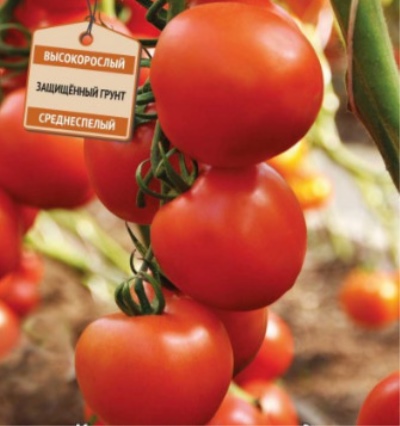
- Authors: Gorshkova Nina Sergeevna, Khovrin Alexander Nikolaevich, Tereshonkova Tatiana Arkadyevna, Kostenko Alexander Nikolaevich
- Year of approval: 2012
- Category: hybrid
- Growth type: indeterminate
- Appointment: universal
- Ripening period: early
- Ripening time, days: 105-110
- Growing conditions: for film greenhouses
- Bush size: tall
- Stem: tight
Choosing between varietal tomatoes and hybrids, many summer residents and farmers prefer hybrid types of tomatoes, since they are characterized by minimal agricultural technology and good yields. Among the popular hybrid varieties, it is worth noting the Scarlet Caravel tomato.
Breeding history
The early ripe tomato Scarlet Caravel was created by domestic scientists in 2012. At the same time, the nightshade culture joined the ranks of the State Register of Breeding Achievements of the Russian Federation, and was also approved for use. The variety has been zoned throughout the country - Central Black Earth District, northern, Far Eastern, Ural, Central regions. The most productive is the tomato growing in film greenhouses.
Description of the variety
Vegetable culture Scarlet caravel is a tall plant of an indeterminate type, stretching up to 170-180 cm in height. The bushes have a powerful central stem, moderate foliage with green leaves, a developed root system and inflorescences of a simple type. In each fruit cluster, from 8 to 11 tomatoes are formed. The formation of bushes of 1-2 stems, the obligatory tying of branches and the trunk to the supports, as well as partial pinching will help to improve the development and productivity of the crop. The purpose of tomatoes is universal, so they are eaten fresh, canned, salted, frozen and processed. The shape and size of the vegetable allows for whole-fruit canning.
The main qualities of the fruit
The Scarlet Caravel tomato is a medium-sized tomato. Tomato grows up to 150-170 grams. In a state of full ripeness, the berry is covered with a uniform red color, and in an unripe form, the tomato is pale green without a spot at the base. The shape of the fetus is non-standard - elliptical (slightly oval). The vegetable is characterized by a dense, but not felt during eating, skin that protects from cracking. The surface of the tomato is perfectly smooth and glossy. A feature of the variety is that almost all tomatoes grow in the same shape and size, which gives them an attractive presentation.
Taste characteristics
Despite the hybridity, tomatoes are endowed with excellent taste. The flesh of the vegetable is fleshy, very dense, with low juiciness. The taste of tomato is dominated by sweetness, which is complemented by light sourness and a pronounced spicy aroma. There are practically no seeds in the pulp.
Ripening and fruiting
The scarlet caravel variety is early maturing. Less than 4 months (105-110 days) pass from the moment of the absolute germination of seedlings to the ripening of the first tomatoes. Abundant fruiting occurs in July-August. The simultaneous ripening of a large number of tomatoes allows them to be harvested with whole fruit clusters. Ripe tomatoes do not crumble.
Yield
The yield of the variety is high, the main thing is to follow the standard agrotechnical recommendations. On average, 1 m2 can grow up to 19.5 kg of tomatoes.
The timing of planting seedlings and planting in the ground
It is recommended to sow seeds for seedlings from March to April, that is, 55-60 days before transfer to the greenhouse. After sowing, the boxes are covered with foil or glass, which will accelerate the germination of seedlings. Bushes grow well with the right temperature and light conditions. At the stage of appearance of 2-3 real leaves, you need to plant the plants in individual containers.
It is recommended to transplant seedlings into a film greenhouse in the second half of May. At this stage, each bush should have a root system, 5-7 leaves and 1 flower brush should appear.

Growing tomato seedlings is an extremely important process, because it largely depends on whether the gardener will be able to harvest at all. All aspects must be taken into account, from seedbed preparation to planting in the ground.
Landing scheme
The density of seedlings placement, as well as the planting pattern, are important indicators that should be strictly observed. 4 bushes can be planted on 1 m2, which will provide access to the sun and air for each plant. The optimal layout for planting is 70x60 cm.

Growing and care
Tomatoes love fertile, loose and breathable soil. The area should be lighted, cleaned and fertilized. The best place is where vegetables such as zucchini, cabbage, radishes or carrots used to grow. Caring for this variety includes: regular watering, top dressing, loosening the soil, lighting, shaping and tying a bush, removing stepchildren, airing, protection from viruses, insects.




A plant needs different micronutrients at each stage of growth. All fertilizers can be divided into two groups: mineral and organic. Folk remedies are often used: iodine, yeast, bird droppings, eggshells.
It is important to observe the rate and period of feeding. This also applies to folk remedies and organic fertilizers.
Disease and pest resistance
High immunity is able to protect tomatoes from cladosporiosis, tobacco mosaic virus and fusarium wilt.


Resistant to adverse weather conditions
The hybrid has a high resistance to stress, so it is not afraid of sudden temperature fluctuations, short drought, heat. The only thing that negatively affects the fruiting of the variety is a lack of lighting and frequent drafts. In plastic greenhouses, it is recommended to control humidity, the excess of which can cause fungus.

























































































